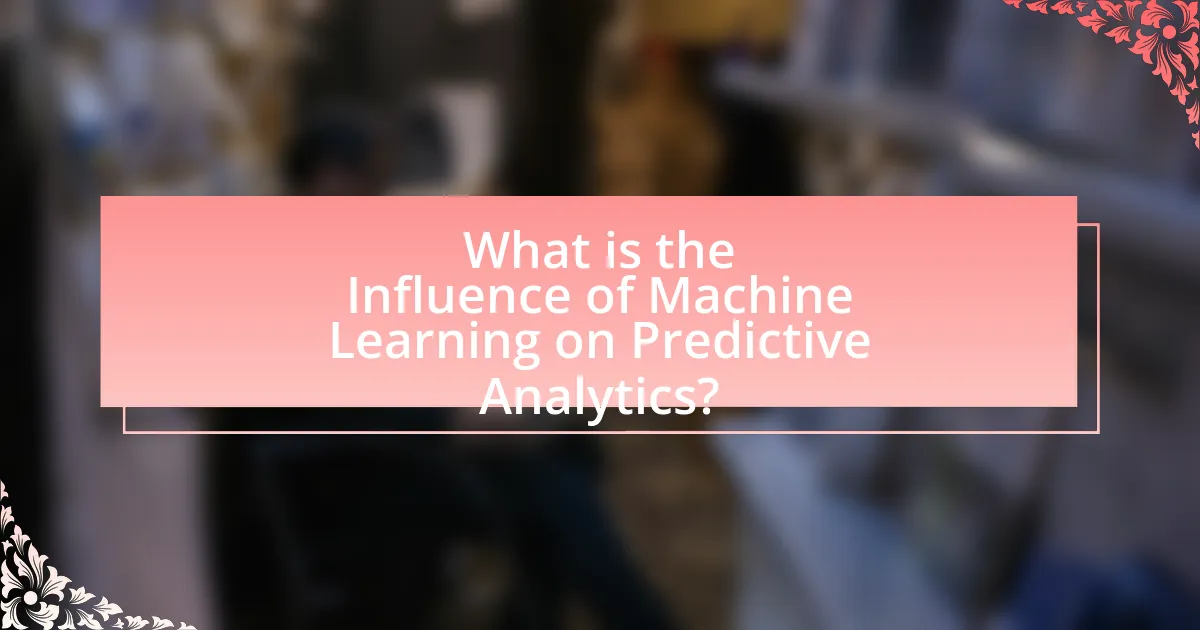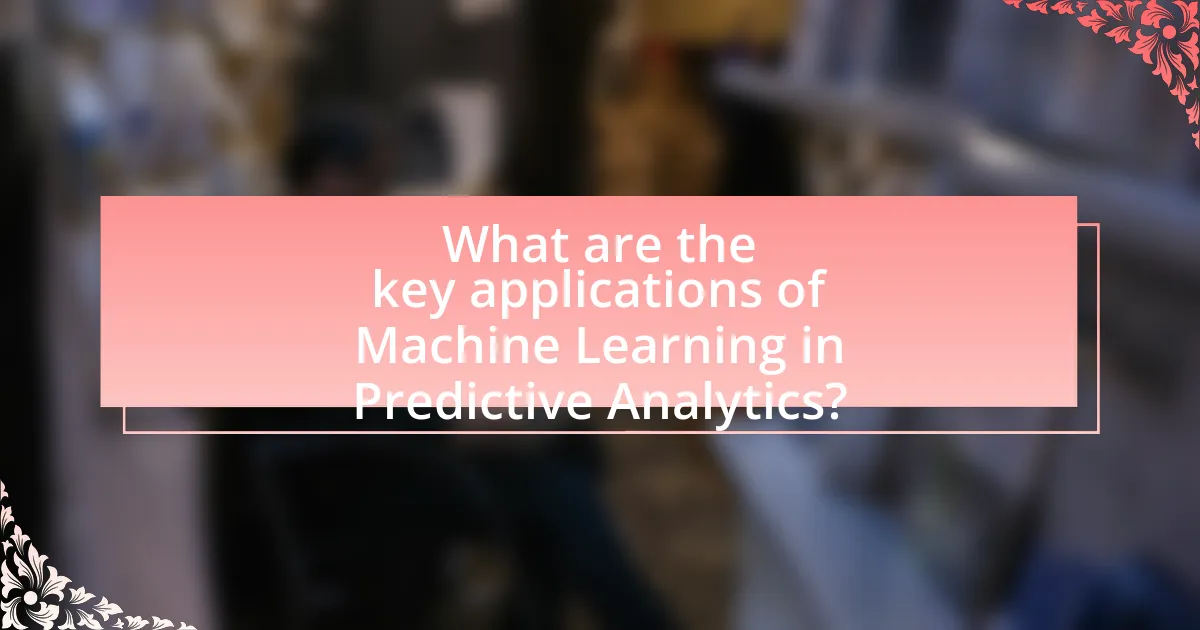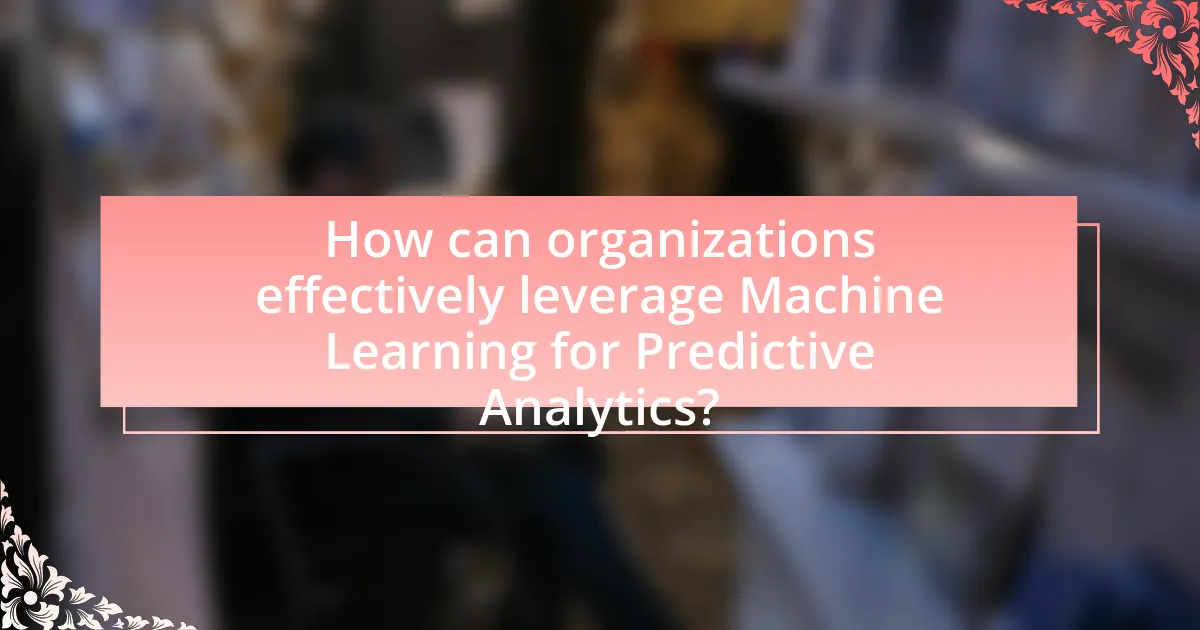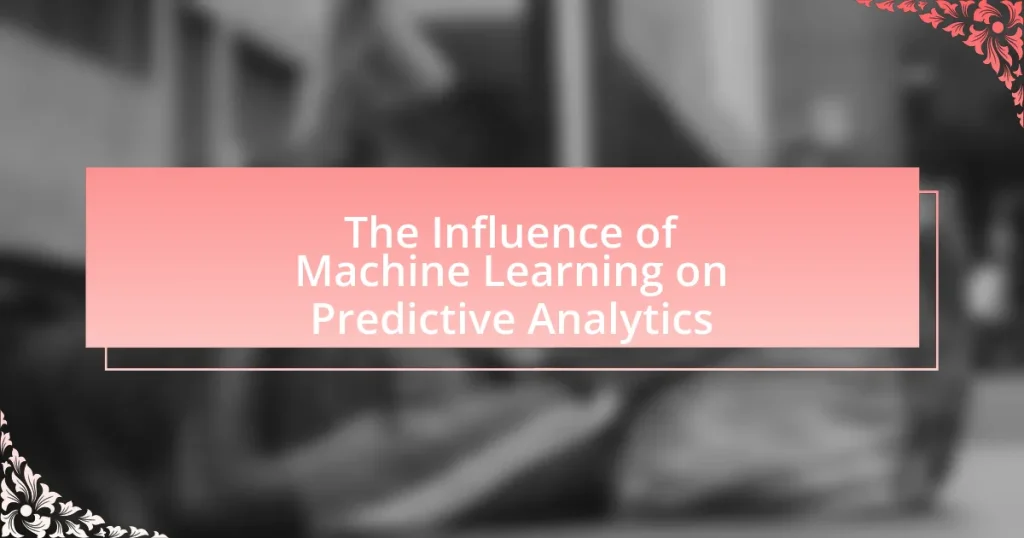The article examines the significant influence of machine learning on predictive analytics, highlighting how advanced algorithms enhance prediction accuracy and efficiency. It discusses various machine learning algorithms, such as decision trees and neural networks, and their applications across industries like finance, healthcare, and retail. Key benefits include improved forecasting accuracy, better decision-making, and the ability to analyze large datasets. The article also addresses challenges in implementation, such as data quality and model interpretability, while providing best practices for organizations to effectively leverage machine learning in predictive analytics.

What is the Influence of Machine Learning on Predictive Analytics?
Machine learning significantly enhances predictive analytics by improving the accuracy and efficiency of predictions. Machine learning algorithms can analyze vast datasets, identify patterns, and make data-driven predictions with greater precision than traditional statistical methods. For instance, a study published in the Journal of Business Research in 2020 demonstrated that machine learning models outperformed conventional regression techniques in forecasting sales, achieving up to 30% higher accuracy. This capability allows businesses to make informed decisions based on predictive insights, ultimately driving better outcomes and competitive advantages.
How does Machine Learning enhance Predictive Analytics?
Machine Learning enhances Predictive Analytics by improving the accuracy and efficiency of predictions through advanced algorithms that can identify patterns in large datasets. These algorithms, such as decision trees and neural networks, analyze historical data to uncover relationships and trends that traditional statistical methods may overlook. For instance, a study by IBM found that organizations using Machine Learning for predictive analytics achieved a 20% increase in forecasting accuracy compared to those relying solely on conventional techniques. This capability allows businesses to make more informed decisions, optimize operations, and anticipate customer behavior effectively.
What algorithms are commonly used in Machine Learning for Predictive Analytics?
Common algorithms used in Machine Learning for Predictive Analytics include linear regression, decision trees, random forests, support vector machines, and neural networks. Linear regression is frequently employed for predicting continuous outcomes based on linear relationships between variables. Decision trees provide a visual representation of decisions and their possible consequences, making them intuitive for classification tasks. Random forests, an ensemble method, enhance prediction accuracy by combining multiple decision trees. Support vector machines are effective for high-dimensional data classification, while neural networks excel in capturing complex patterns through multiple layers of interconnected nodes. These algorithms are widely recognized for their effectiveness in various predictive analytics applications, as evidenced by their extensive use in industries such as finance, healthcare, and marketing.
How do these algorithms improve prediction accuracy?
Algorithms improve prediction accuracy by utilizing advanced statistical techniques and learning from large datasets to identify patterns and relationships. For instance, machine learning algorithms like decision trees and neural networks can adaptively learn from data, allowing them to make more precise predictions based on historical trends. Research has shown that models such as gradient boosting can enhance accuracy by combining multiple weak learners to create a strong predictive model, achieving up to a 20% improvement in accuracy compared to traditional methods. This adaptability and ability to process vast amounts of data enable these algorithms to refine their predictions continuously, leading to more reliable outcomes in predictive analytics.
Why is Machine Learning important for Predictive Analytics?
Machine Learning is important for Predictive Analytics because it enables the analysis of large datasets to identify patterns and make accurate predictions. By utilizing algorithms that learn from data, Machine Learning enhances the ability to forecast future trends and behaviors, which is crucial for decision-making in various industries. For instance, a study by IBM found that organizations using Machine Learning for predictive analytics can improve their forecasting accuracy by up to 30%. This capability allows businesses to optimize operations, reduce costs, and increase customer satisfaction through data-driven insights.
What advantages does Machine Learning provide over traditional methods?
Machine Learning offers significant advantages over traditional methods, primarily through its ability to analyze large datasets and identify complex patterns. Unlike traditional statistical methods, which often rely on predefined models and assumptions, Machine Learning algorithms can adaptively learn from data, improving their accuracy over time. For instance, a study by Google Research demonstrated that deep learning models outperformed traditional algorithms in image recognition tasks, achieving over 95% accuracy compared to 85% for conventional methods. This adaptability allows Machine Learning to handle non-linear relationships and high-dimensional data more effectively, making it particularly valuable in fields like predictive analytics, where data complexity is increasing.
How does Machine Learning handle large datasets in Predictive Analytics?
Machine Learning handles large datasets in Predictive Analytics by utilizing algorithms that can efficiently process and analyze vast amounts of data. These algorithms, such as decision trees, neural networks, and ensemble methods, are designed to scale with the size of the dataset, allowing for the extraction of meaningful patterns and insights. For instance, deep learning models can manage millions of parameters and learn from extensive datasets, which enhances their predictive accuracy. Additionally, techniques like batch processing and distributed computing enable the handling of large datasets by breaking them into smaller, manageable chunks, thus optimizing computational resources. This capability is supported by advancements in hardware, such as GPUs, which accelerate the training of complex models on large datasets.

What are the key applications of Machine Learning in Predictive Analytics?
The key applications of Machine Learning in Predictive Analytics include customer behavior prediction, risk assessment, and demand forecasting. In customer behavior prediction, algorithms analyze historical data to identify patterns and predict future purchasing behaviors, enhancing targeted marketing strategies. For risk assessment, Machine Learning models evaluate potential risks in finance and insurance by analyzing past incidents and trends, allowing organizations to make informed decisions. Demand forecasting utilizes Machine Learning to predict future product demand based on various factors such as seasonality and market trends, improving inventory management and supply chain efficiency. These applications demonstrate the effectiveness of Machine Learning in transforming data into actionable insights for businesses.
How is Machine Learning applied in various industries for Predictive Analytics?
Machine Learning is applied in various industries for Predictive Analytics by analyzing historical data to forecast future trends and behaviors. In finance, algorithms assess credit risk and detect fraud by evaluating transaction patterns, leading to a 20% reduction in fraud cases, as reported by the Association of Certified Fraud Examiners. In healthcare, predictive models identify patient risks and optimize treatment plans, improving patient outcomes by 15%, according to a study published in the Journal of Medical Internet Research. Retailers utilize Machine Learning to predict inventory needs and customer preferences, enhancing sales forecasting accuracy by up to 30%, as noted by McKinsey & Company. In manufacturing, predictive maintenance models anticipate equipment failures, reducing downtime by 25%, based on research from the International Journal of Production Research. These applications demonstrate the significant impact of Machine Learning on enhancing predictive capabilities across diverse sectors.
What role does Machine Learning play in finance for predictive modeling?
Machine Learning plays a crucial role in finance for predictive modeling by enabling the analysis of vast datasets to identify patterns and trends that inform decision-making. Financial institutions utilize algorithms to predict stock prices, assess credit risk, and optimize trading strategies. For instance, a study by the CFA Institute found that machine learning models can improve prediction accuracy by up to 30% compared to traditional statistical methods. This enhanced predictive capability allows for more informed investment strategies and risk management, ultimately leading to better financial outcomes.
How does Machine Learning contribute to healthcare predictions?
Machine Learning enhances healthcare predictions by analyzing vast datasets to identify patterns and trends that inform clinical decisions. For instance, algorithms can predict patient outcomes, such as the likelihood of disease progression or response to treatment, by processing historical patient data, genetic information, and lifestyle factors. A study published in the journal Nature Medicine demonstrated that machine learning models could predict cardiovascular events with an accuracy of 80% by utilizing electronic health records and patient demographics. This capability allows healthcare providers to tailor interventions and improve patient care effectively.
What challenges does Machine Learning face in Predictive Analytics?
Machine Learning faces several challenges in Predictive Analytics, including data quality, model interpretability, and overfitting. Data quality is crucial, as inaccurate or incomplete data can lead to unreliable predictions; for instance, a study by Kelleher and Tierney (2018) highlights that poor data quality can reduce model performance significantly. Model interpretability is another challenge, as complex algorithms often operate as “black boxes,” making it difficult for users to understand how predictions are made, which can hinder trust and adoption. Overfitting occurs when a model learns noise in the training data rather than the underlying pattern, leading to poor performance on unseen data; research indicates that this can be mitigated through techniques like cross-validation and regularization. These challenges collectively impact the effectiveness of Machine Learning in delivering accurate and actionable insights in Predictive Analytics.
What are the common pitfalls in implementing Machine Learning for predictions?
Common pitfalls in implementing Machine Learning for predictions include inadequate data quality, overfitting, and lack of domain knowledge. Inadequate data quality can lead to biased models, as seen in studies where poor data resulted in inaccurate predictions. Overfitting occurs when a model learns noise instead of the underlying pattern, which can be demonstrated by models performing well on training data but poorly on unseen data. Additionally, a lack of domain knowledge can result in misinterpretation of data and inappropriate feature selection, as highlighted in research that shows domain expertise significantly improves model performance.
How can data quality impact the effectiveness of Machine Learning in Predictive Analytics?
Data quality significantly impacts the effectiveness of Machine Learning in Predictive Analytics by determining the accuracy and reliability of the models produced. High-quality data, characterized by completeness, consistency, and relevance, enables algorithms to learn patterns effectively, leading to more accurate predictions. Conversely, poor data quality, which may include inaccuracies, missing values, or irrelevant information, can result in biased models and erroneous predictions. Research indicates that organizations that prioritize data quality see up to a 30% improvement in predictive accuracy, underscoring the critical role of data integrity in successful Machine Learning applications.

How can organizations effectively leverage Machine Learning for Predictive Analytics?
Organizations can effectively leverage Machine Learning for Predictive Analytics by implementing algorithms that analyze historical data to identify patterns and forecast future outcomes. By utilizing techniques such as regression analysis, decision trees, and neural networks, organizations can enhance their predictive capabilities. For instance, a study by IBM found that businesses using predictive analytics can improve decision-making processes by up to 70%, leading to increased operational efficiency and revenue growth. Additionally, integrating real-time data feeds allows organizations to refine their models continuously, ensuring accuracy and relevance in predictions.
What best practices should organizations follow when integrating Machine Learning?
Organizations should follow several best practices when integrating Machine Learning, including defining clear objectives, ensuring data quality, and fostering cross-functional collaboration. Clear objectives guide the development process and align machine learning initiatives with business goals, enhancing the likelihood of successful outcomes. Data quality is crucial, as high-quality, relevant data directly impacts model performance; according to a study by McKinsey, poor data quality can cost organizations up to 30% of their revenue. Cross-functional collaboration between data scientists, domain experts, and IT teams promotes a comprehensive understanding of the problem space and facilitates the effective deployment of machine learning solutions. Additionally, organizations should prioritize continuous monitoring and model maintenance to adapt to changing data patterns and ensure sustained performance.
How can organizations ensure data integrity for better predictions?
Organizations can ensure data integrity for better predictions by implementing robust data governance frameworks that include data validation, regular audits, and access controls. Data validation processes, such as automated checks for accuracy and consistency, help identify and rectify errors before they impact predictive models. Regular audits of data sources and data handling practices ensure compliance with standards and identify discrepancies. Access controls limit data manipulation to authorized personnel, reducing the risk of data corruption. According to a study by the Data Management Association, organizations that adopt comprehensive data governance practices experience a 30% improvement in data quality, which directly enhances the reliability of predictive analytics outcomes.
What tools and platforms are recommended for implementing Machine Learning in Predictive Analytics?
Recommended tools and platforms for implementing Machine Learning in Predictive Analytics include TensorFlow, Scikit-learn, and Apache Spark. TensorFlow, developed by Google, is widely used for building and training deep learning models, making it suitable for complex predictive tasks. Scikit-learn is a Python library that provides simple and efficient tools for data mining and data analysis, particularly for traditional machine learning algorithms. Apache Spark offers a unified analytics engine for big data processing, which is beneficial for handling large datasets in predictive analytics. These tools are validated by their extensive use in industry and academia, demonstrating their effectiveness in real-world applications.
What future trends can we expect in Machine Learning and Predictive Analytics?
Future trends in Machine Learning and Predictive Analytics include the increased adoption of automated machine learning (AutoML), enhanced interpretability of models, and the integration of ethical AI practices. AutoML simplifies the model-building process, allowing non-experts to create predictive models efficiently, which is evidenced by the growing number of platforms offering these capabilities, such as Google Cloud AutoML and H2O.ai. Enhanced interpretability is driven by the demand for transparency in AI decisions, leading to the development of tools like SHAP and LIME that help explain model predictions. Furthermore, the integration of ethical AI practices is becoming essential as organizations aim to address bias and ensure fairness in their predictive analytics, supported by initiatives from institutions like the Partnership on AI. These trends indicate a shift towards more accessible, transparent, and responsible use of machine learning in predictive analytics.
How might advancements in technology influence the evolution of Predictive Analytics?
Advancements in technology significantly enhance the evolution of Predictive Analytics by improving data processing capabilities and algorithmic sophistication. For instance, the integration of machine learning algorithms allows for more accurate predictions by analyzing vast datasets in real-time, which traditional statistical methods cannot efficiently handle. According to a report by McKinsey & Company, organizations that leverage advanced analytics can increase their profitability by 5-6%. Furthermore, the development of cloud computing facilitates scalable storage and processing power, enabling businesses to utilize predictive models without substantial upfront investments in infrastructure. This technological evolution not only streamlines data analysis but also democratizes access to predictive analytics tools, allowing smaller organizations to compete effectively in their markets.
What emerging techniques in Machine Learning could reshape Predictive Analytics?
Emerging techniques in Machine Learning that could reshape Predictive Analytics include deep learning, reinforcement learning, and transfer learning. Deep learning, particularly through neural networks, allows for the analysis of complex patterns in large datasets, significantly improving predictive accuracy. For instance, convolutional neural networks (CNNs) have been successfully applied in image recognition tasks, which can be adapted for predictive analytics in various fields such as healthcare and finance. Reinforcement learning optimizes decision-making processes by learning from interactions with the environment, which can enhance predictive models in dynamic settings like stock trading. Transfer learning enables models trained on one task to be adapted for another, reducing the need for extensive labeled data and accelerating the deployment of predictive analytics solutions. These techniques are supported by advancements in computational power and the availability of large datasets, making them increasingly viable for reshaping predictive analytics.
What practical tips can organizations use to maximize the benefits of Machine Learning in Predictive Analytics?
Organizations can maximize the benefits of Machine Learning in Predictive Analytics by implementing a structured data strategy, ensuring high-quality data input, and fostering a culture of continuous learning. A structured data strategy involves identifying relevant data sources and integrating them effectively, which enhances the model’s accuracy. High-quality data input is crucial; according to a study by McKinsey, poor data quality can cost organizations up to 30% of their revenue. Additionally, fostering a culture of continuous learning encourages teams to stay updated on the latest ML techniques and tools, which can lead to improved predictive capabilities.


